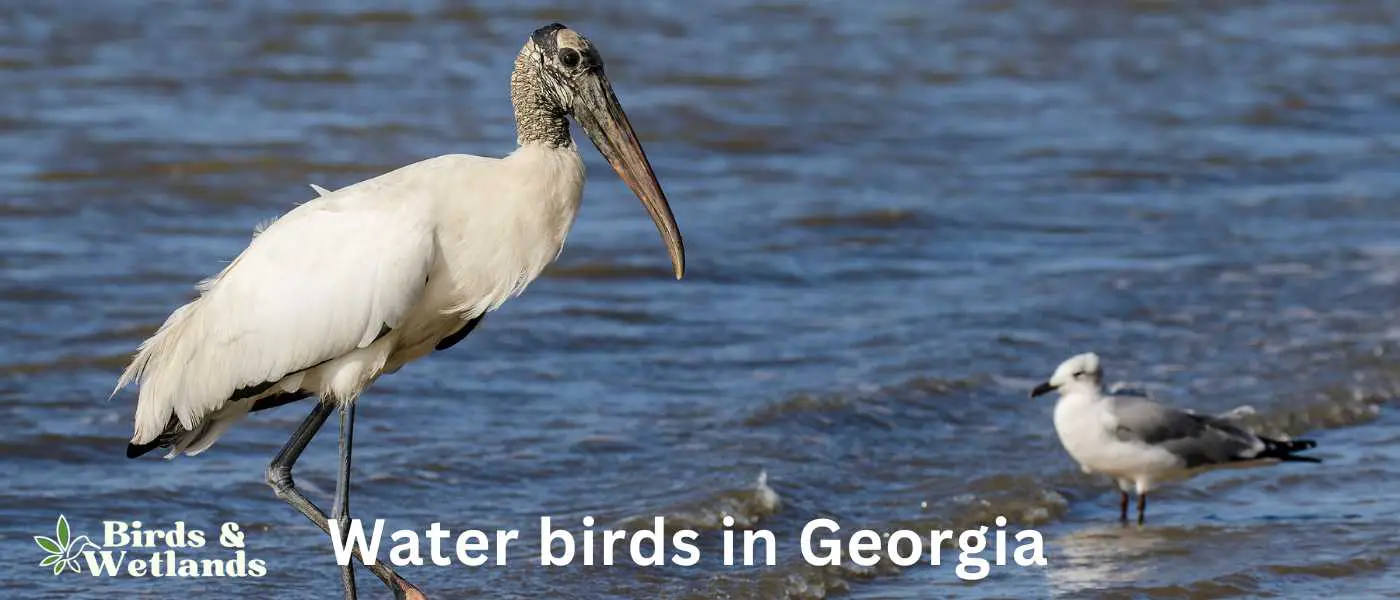In Georgia, where the South’s lush landscapes meet the Atlantic Ocean, one finds an exceptional variety of water birds. The state’s diverse ecosystems, ranging from the coastal marshlands to the tranquil shores of its numerous lakes, rivers, and reservoirs, provide a bountiful habitat for these captivating creatures.
Georgia water birds
| Water Bird SpeciesFrequency in GeorgiaSpecific Locations in Georgia | ||
|---|---|---|
| American White Pelican | Common | Altamaha Wildlife Management Area, Lake Seminole |
| Brown Pelican | Common | Coastal Georgia, especially Tybee Island |
| Double-Crested Cormorant | Very Common | Most large lakes and rivers throughout the state |
| Anhinga | Common | Wetlands in the southern part of the state |
| Great Blue Heron | Very Common | Across the state in wetland areas |
| Great Egret | Very Common | Coastal areas and large inland lakes |
| Snowy Egret | Common | Coastal Georgia, especially near Savannah |
| Green Heron | Common | Inland wetlands and ponds |
| Tricolored Heron | Common | Coastal Georgia, especially near Savannah |
| Little Blue Heron | Common | Coastal and wetland areas |
| Black-Crowned Night-Heron | Common | Coastal wetland areas |
| Yellow-Crowned Night-Heron | Common | Coastal and riverine areas |
| White Ibis | Common | Coastal Georgia, especially near Savannah |
| Glossy Ibis | Common | Wetlands in the southern part of the state |
| Wood Stork | Common | Southern wetlands, Harris Neck National Wildlife Refuge |
| Mallard | Very Common | Wetland areas throughout the state |
| Mottled Duck | Common | Wetlands in the southern part of the state |
| Red-Breasted Merganser | Common | Coastal areas in winter |
| American Coot | Very Common | Throughout the state in large bodies of water |
| Bald Eagle | Common | Across the state near large bodies of water |
| Osprey | Common | Lakes and rivers throughout the state |
| Northern Pintail | Common | Wetlands in winter |
| Wood Duck | Very Common | Wetlands throughout the state |
| American Oystercatcher | Common | Coastal Georgia, especially Little St. Simons Island |
| Black Skimmer | Common | Coastal beaches and estuaries |
Water Bird Species Found in Georgia
American White Pelican


| Feature | Measurement |
|---|---|
| Scientific Name | Pelecanus erythrorhynchos |
| Length | 50–70 in |
| Wingspan | 95–120 in |
| Weight | 3.5 and 13.6 kg |
The American White Pelican (Pelecanus erythrorhynchos) is one of North America’s largest birds, distinguished by its brilliant white plumage, elongated orange bill, and massive wingspan, which can extend up to 3 meters. This bird has a unique appearance with its distinctive pouch used for feeding and a “horn” on the upper part of the bill during the breeding season. Though a large bird, it is very graceful in flight, often seen soaring in flocks in a V formation.
American White Pelicans inhabit lakes, marshes, and salt bays, and despite their size, they are excellent swimmers. They feed primarily on fish, using a cooperative hunting strategy where they encircle schools of fish in shallow water and then scoop them up in their bill pouches. Unlike their brown pelican relatives, they do not dive for their food. During the breeding season, these pelicans will nest in colonies on islands in freshwater lakes.
Brown Pelican (Pelecanus occidentalis)
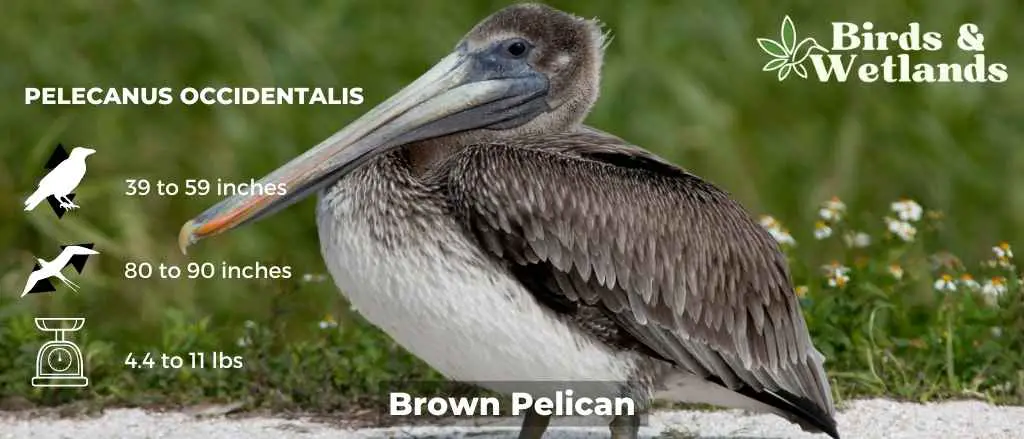
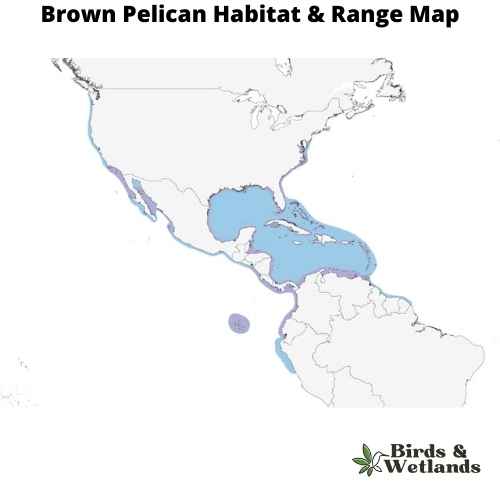
Listen:
Scientific Name: Pelecanus occidentalis
Length: 3 ft 3 in to 5 ft 0 in
Wingspan: 6 ft 8 in to 7 ft 6 in
Weight: 4.4 to 11.0 lb
The Brown Pelican is a large water bird famous for its distinct body shape and dramatic feeding habits. Known for their habit of diving headfirst into the water to catch fish, they are a staple along the coasts of the southern United States.
Appearance: Brown Pelicans are easily identifiable due to their long, curved necks, stout bodies, and large bills with a stretchy pouch. As their name suggests, they have brown and gray body feathers, with a paler head and neck that can become yellowish in breeding season.
Diet: Their diet mainly consists of fish, which they catch by making spectacular plunging dives from the air, scooping up the fish in their expandable bill pouches. They then drain the water from their pouches before swallowing their catch.
Reproduction: Brown Pelicans nest in colonies on islands, laying 2 to 3 eggs in nests made from sticks and vegetation. Both parents share incubation and feeding duties. After hatching, the chicks remain in the nest for around 12 weeks before they are ready to leave.
Double-crested cormorant

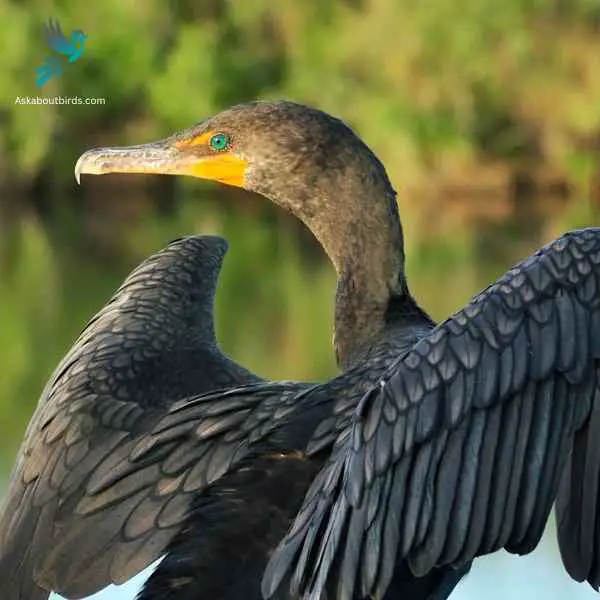
| Feature | Measurement |
|---|---|
| Scientific Name | Nannopterum auritum |
| Length | 28–35 in |
| Wingspan | 45–48 in |
| Weight | 1.2–2.5 kg |
The Double-Crested Cormorant (Phalacrocorax auritus) is a large waterbird known for its long neck, hooked bill, and almost entirely black body. The species gets its name from the two small patches of tufted feathers or “crests” found on the heads of breeding adults, one on each side. These birds are strong swimmers that propel themselves underwater with their webbed feet, their bodies submerged and necks above the water surface, giving them a characteristic snake-like appearance when swimming.
Double-Crested Cormorants are widely distributed across North America and can be found in a variety of aquatic environments including freshwater lakes, coastal areas, and rivers. Their diet primarily consists of fish, which they catch by diving from the water’s surface. Often seen perched with wings outstretched to dry after fishing, these cormorants nest in trees, on the ground, or on cliff edges, usually in colonies. While they have rebounded from decreases in the mid-20th century due to DDT-related reproductive failures, they face ongoing threats from habitat loss, entanglement in fishing gear, and conflicts with fisheries over their consumption of fish. Protection and careful management of their habitats are key to their ongoing conservation.
Anhinga (Anhinga anhinga)
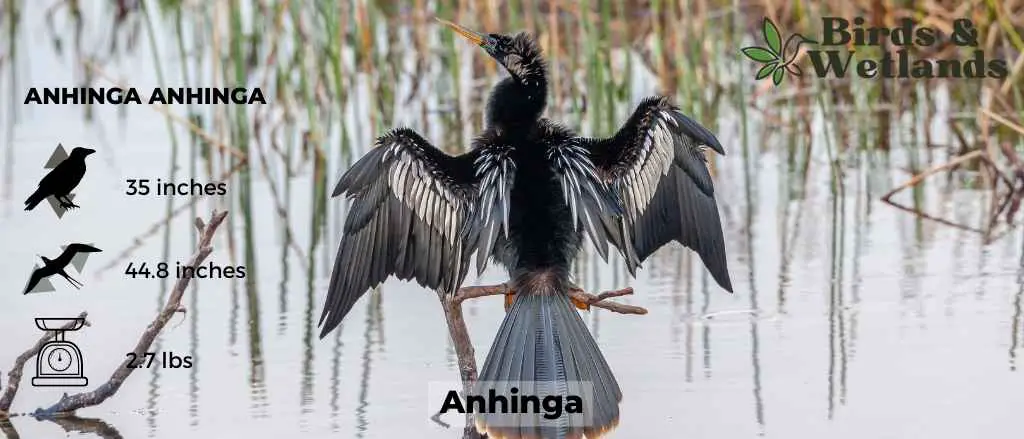
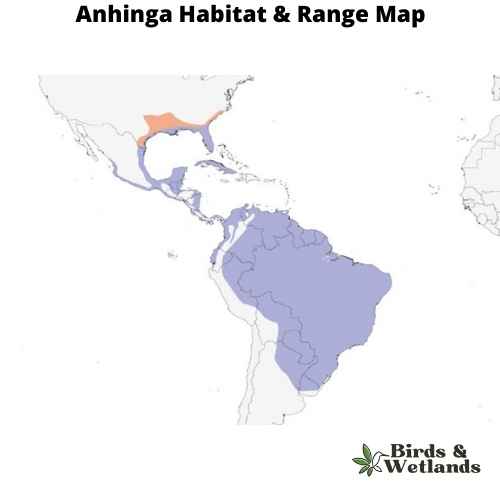
Listen
Scientific Name: Anhinga anhinga
Length: 35 in
Wingspan: 3.7 ft
Weight: 2.7 lb
The Anhinga is a distinctive water bird commonly found in the southern parts of the United States. It is often referred to as the “snakebird” because of its long neck, which often protrudes from the water while the rest of its body is submerged.
Appearance: The Anhinga has a slim body with a long neck and a pointed bill. The males are dark overall with silver wing patches, while females have a pale head, neck, and upper chest contrasting with a dark lower body. When in flight, the Anhinga’s long tail and broad wings are noticeable.
Diet: Anhingas are carnivorous birds primarily feeding on fish. They are excellent divers and often swim submerged, with only their neck visible above water, stalking their aquatic prey. They also eat other aquatic creatures such as insects, crustaceans, and amphibians.
Reproduction: Anhingas breed in colonies, often with other water birds. They build stick nests in trees or shrubs near water. The female lays 2 to 4 eggs that are incubated by both parents for about 25 to 30 days. The young are cared for by both parents and start to fly after about six weeks.
Great Blue Heron


| Feature | Measurement |
|---|---|
| Scientific Name | Ardea herodias |
| Length | 36–54 in |
| Wingspan | 66–79 in |
| Weight | 1.82–3.6 kgs |
Great Blue Herons are the largest heron species in North America, is distinguished by its tall stature and unique blue-gray plumage.
Measuring up to 4.5 feet tall with a wingspan of approximately 6.5 feet, the bird features a long, pointed bill, a white head with a black eye stripe extending to slender black plumes, and robust, elongated legs. Its distinctive flight pattern, forming a tight “S” shape with its neck, sets it apart from similar large birds, like cranes.
Inhabiting various wetland habitats, including marshes, lakes, rivers, and coastal regions throughout much of North and Central America, the Great Blue Heron is a wading bird. Often seen poised statue-like at the water’s edge, these birds are expert hunters, spearing fish and capturing small animals with their sharp bills.
Great Egret


| Feature | Measurement |
|---|---|
| Scientific Name | Ardea alba |
| Length | 31 to 41 in |
| Wingspan | 52 to 67 in |
| Weight | 1.5 to 3.3 lbs |
The Great Egret (Ardea alba), also known as the Common Egret, is a large, elegant wading bird recognized for its brilliant white plumage, slender black legs, and long, dagger-like yellow bill.
With a height of up to 3.3 feet and a wingspan of 52 to 67 inches, this bird is amongst the largest of the heron species. Its stately appearance and serene comportment have made it a popular symbol in many cultures and an eye-catching sight in its habitats.
Found across all continents except Antarctica, the Great Egret resides in both fresh and saltwater wetlands, including marshes, ponds, and coastal areas. It feeds mainly on fish, but it also hunts amphibians, small mammals, and invertebrates.
Snowy Egret

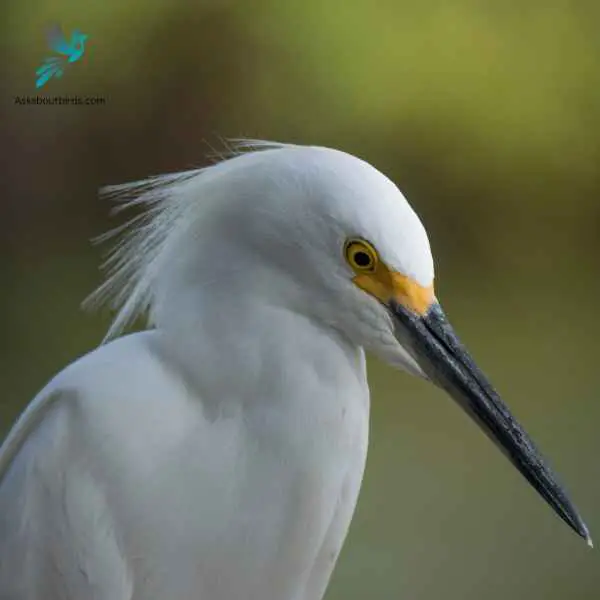
| Feature | Measurement |
|---|---|
| Scientific Name | Egretta thula |
| Length | 22.1–26.0 in |
| Wingspan | 39.4 in |
| Weight | 370 g |
The Snowy Egret (Egretta thula) is a small and active wading bird, celebrated for its delicate beauty. It sports an entirely white plumage that appears to glow against its black bill and legs, and striking yellow feet, which often play a crucial role in luring prey during feeding.
The Snowy Egret is further adorned with fine, plume-like feathers on its head, neck, and back during the breeding season, making it one of the more distinctive heron species.
Inhabiting wetland areas across the Americas, the Snowy Egret can be found in marshes, swamps, shorelines, and tidal flats where it feeds primarily on fish, but also consumes insects, crustaceans, and small reptiles.
Green Heron

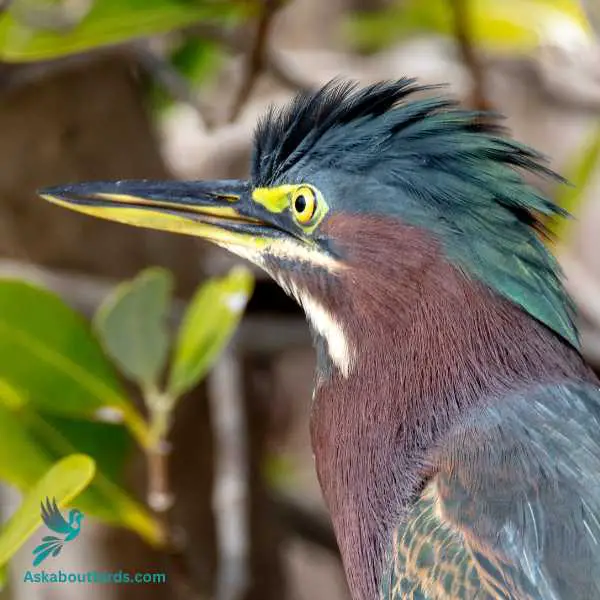
| Feature | Measurement |
|---|---|
| Scientific Name | Butorides virescens |
| Length | 16-18 inches |
| Wingspan | 25-27 inches |
| Weight | 6-7 ounces |
The Green Heron is a small heron found in North America, notable for its deep green back and chestnut body, as well as its unique fishing tactics.
Appearance: Green Herons are dark and compact birds with a glossy, greenish-black cap, a greenish back and wings, and chestnut neck and belly. The bill is long, dark and sharply pointed. Their legs are bright orange or yellow. Young birds are duller in color, with a dark top and streaked brown front.
Diet: The Green Heron’s diet is quite varied, consisting mostly of small fish, but also includes insects, spiders, and sometimes amphibians and small mammals. It’s known for its tool-using behavior where it drops bait onto the water’s surface to attract fish.
Reproduction: Green Herons are solitary birds except during the breeding season, where they form monogamous pairs. Nests are typically built in trees or shrubs near water. Females lay 2 to 5 pale blue-green eggs that both parents incubate.
Tricolored Heron (Egretta tricolor)
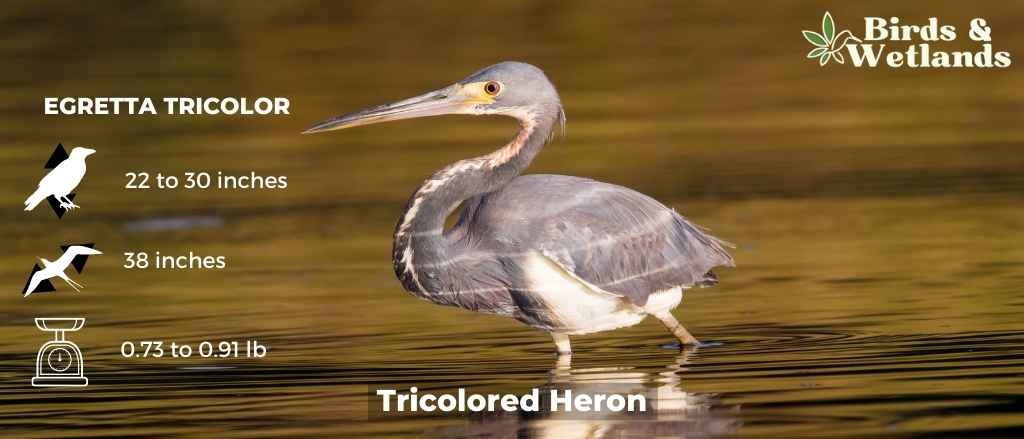
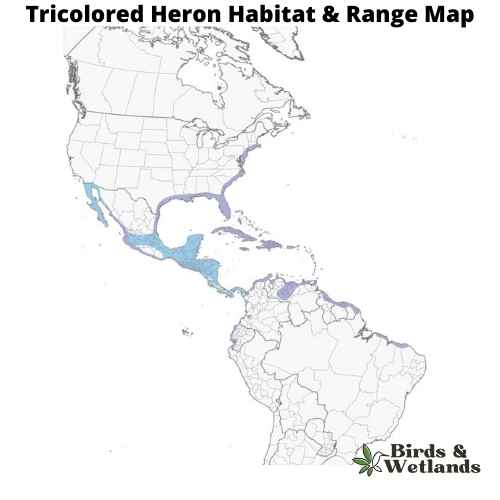
Listen:
Scientific Name: Egretta tricolor
Length: 22 to 30 in
Wingspan: 37 to 39 in
Weight: 11-15oz
The Tricolored Heron, formerly known as the Louisiana Heron, is a slender and elegant bird primarily found in coastal habitats in the southeastern United States.
Appearance: The Tricolored Heron is notable for its slate-gray body, white belly, and a rust-colored neck, which gives it a tricolor appearance. The bill is long and pointed, ideal for catching prey. In breeding season, adults develop white plumes on their back and a blue bill with a bright blue base.
Diet: Tricolored Herons primarily feed on fish, but their diet also includes a variety of other aquatic organisms like crustaceans, amphibians, and insects. They often feed alone, moving slowly through wetlands or standing still, waiting for prey to come within striking distance.
Reproduction: Tricolored Herons nest in colonies, often with other heron and egret species. The nests are constructed from sticks and located in trees or shrubs, usually over water. The female lays 3 to 4 blue-green eggs that are incubated by both parents for about 21-25 days. Once hatched, the young are cared for by both parents and fledge in about five weeks.
Little Blue Heron
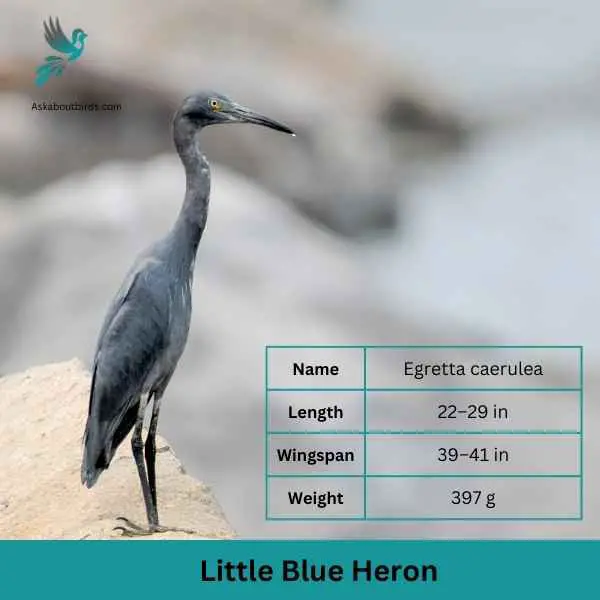
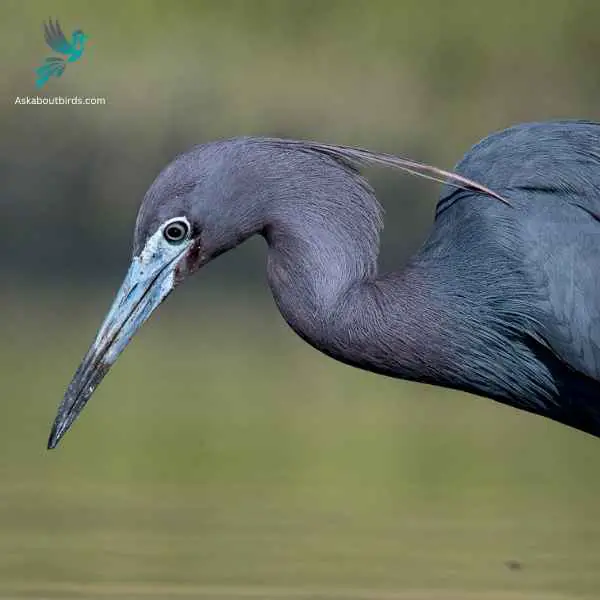
| Feature | Measurement |
|---|---|
| Scientific Name | Egretta caerulea |
| Length | 22–29 in |
| Wingspan | 39–41 in |
| Weight | 397 g |
The Little Blue Heron is a slender and elegant wading bird, often seen foraging in freshwater or saltwater habitats, especially in the southeastern parts of the United States.
Appearance: This heron undergoes a fascinating color transition as it matures. Juvenile Little Blue Herons are white, but they gradually acquire the slate-blue plumage that characterizes adults. The adult has a dark blue-gray body with a purplish neck and head. Their bill is grayish with a black tip.
Diet: The diet of the Little Blue Heron consists mainly of small fish, but they also feed on crustaceans, insects, and other small aquatic animals. Using stealth, they slowly stalk their prey in shallow waters before striking with their long, sharp bill.
Reproduction: Little Blue Herons nest in colonies, often with other wading birds. They build platform nests in trees or shrubs close to water bodies. The female typically lays a clutch of 3 to 5 pale blue eggs. Both parents participate in incubation and feeding the chicks once they hatch.
Black-Crowned Night-Heron
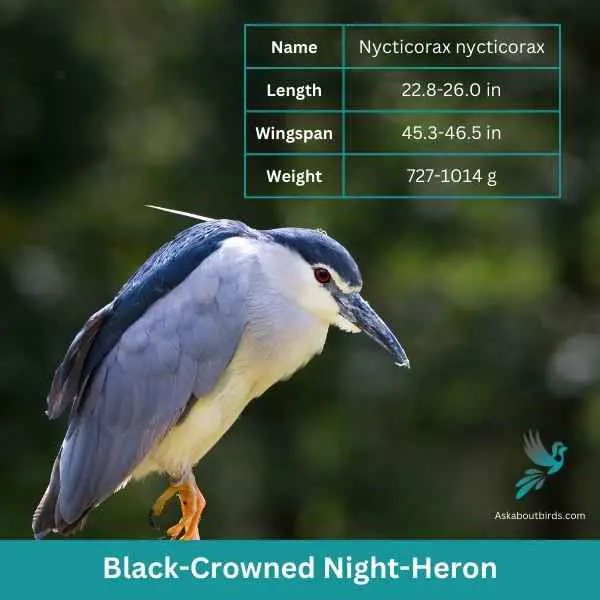
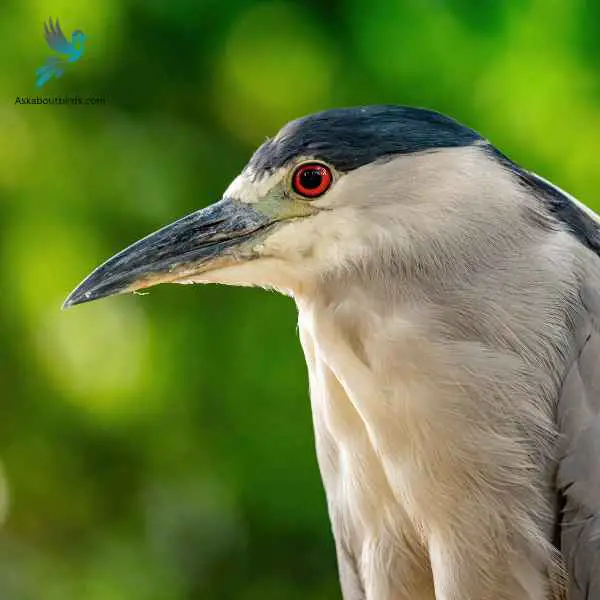
| Feature | Measurement |
|---|---|
| Scientific Name | Nycticorax nycticorax |
| Length | 22.8-26.0 in |
| Wingspan | 45.3-46.5 in |
| Weight | 727-1014 g |
The Black-Crowned Night-Heron (Nycticorax nycticorax) is a medium-sized heron species known for its distinct nocturnal habits and characteristic appearance. The bird displays a stocky silhouette, with a black crown and back, contrasting starkly with its light grey wings and white underparts.
Its eyes are large and red, adapted for its night-time activities, and its legs are relatively short for a heron. The bill is sturdy and black, and during the breeding season, two to three long white plumes extend from the back of the head.
Residing in a wide variety of wetland habitats, from freshwater marshes to coastal regions, the Black-Crowned Night-Heron is found across a large global range, including the Americas, Europe, Asia, and Africa. The species primarily feeds on fish and invertebrates, but it is known to be opportunistic and will also eat small mammals, birds, and eggs.
Yellow-crowned Night-Heron (Nyctanassa violacea)

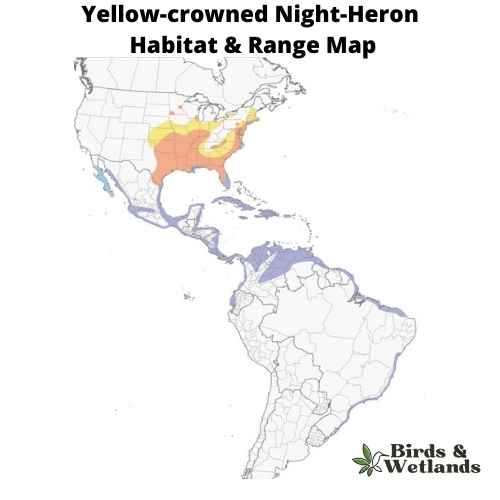
Listen:
Scientific Name: Nyctanassa violacea
Length: 1 ft 10 in – 2 ft 4 in
Wingspan:
Weight: 1.43–1.87 lb
The Yellow-crowned Night Heron is a medium-sized heron commonly found in wetlands and coastal habitats across the southeastern United States.
Appearance: Yellow-crowned Night Herons have a sturdy body with a comparatively short neck and legs. Their distinctive feature is their namesake yellow crown, which contrasts sharply with their gray body and back. They have red eyes and a heavy, dark bill. During the breeding season, they develop long, wispy plumes on their head, giving them a stylish appearance.
Diet: Yellow-crowned Night Herons are known for their preference for crustaceans, especially crabs and crayfish. They hunt mostly at night, stalking their prey in shallow water, often remaining still for long periods before striking quickly with their bill.
Reproduction: Yellow-crowned Night Herons nest in small colonies, typically in trees or shrubs near water. The female lays 3 to 5 pale blue-green eggs which are incubated by both parents for about 25 days. After hatching, the chicks are cared for by both parents and fledge in about 30-40 days. They often return to the same nesting sites year after year.
White Ibis (Eudocimus albus)
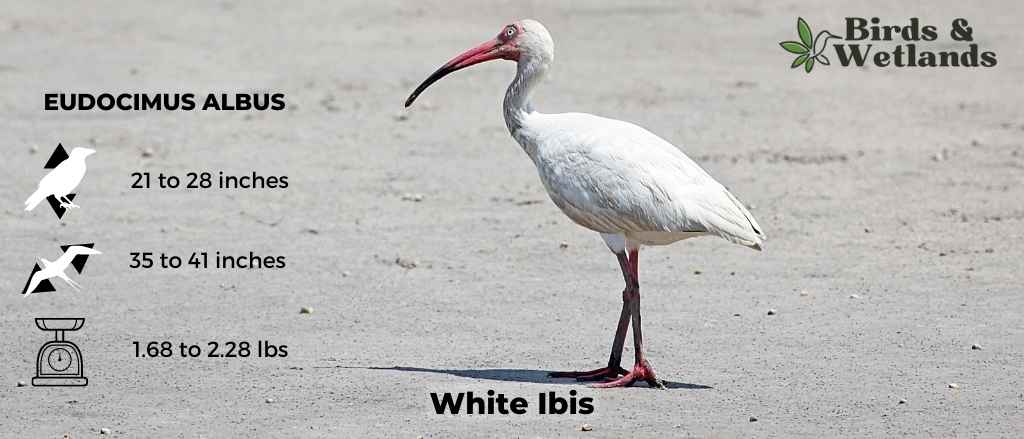
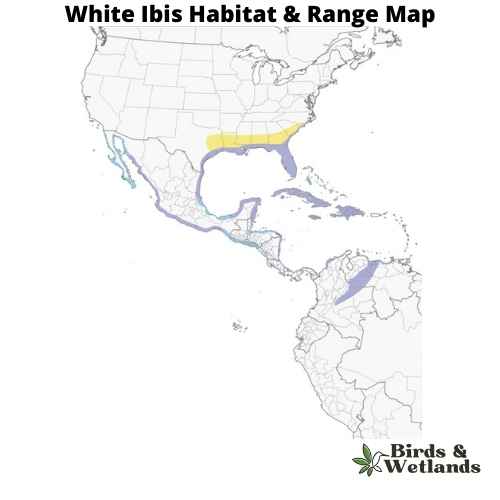
Listen:
Scientific Name: Eudocimus albus
Length: 21 to 28 in
Wingspan: 35 to 41 in
Weight: 1.6 – 2.3lb
The White Ibis is a wading bird renowned for its bright white plumage and distinctive, down-curved bill. It’s most commonly found in the marshes, wetlands, and along the coastlines of the southeastern United States.
Appearance: White Ibises display a predominantly white plumage that’s contrasted by their brilliant red-orange down-curved bill and legs. During the breeding season, the skin on their face may become dark blue. Juvenile White Ibises have brown upper parts and white underparts.
Diet: The diet of the White Ibis primarily consists of various invertebrates, including insects, crayfish, and other small crustaceans. Their long, curved bill is perfectly adapted for probing in mud and shallow water while foraging for food.
Reproduction: White Ibises nest in large colonies, often with other wading birds. The female typically lays 2 to 4 eggs in a nest made of twigs and leaves in trees or shrubs.
Glossy Ibis (Plegadis falcinellus)
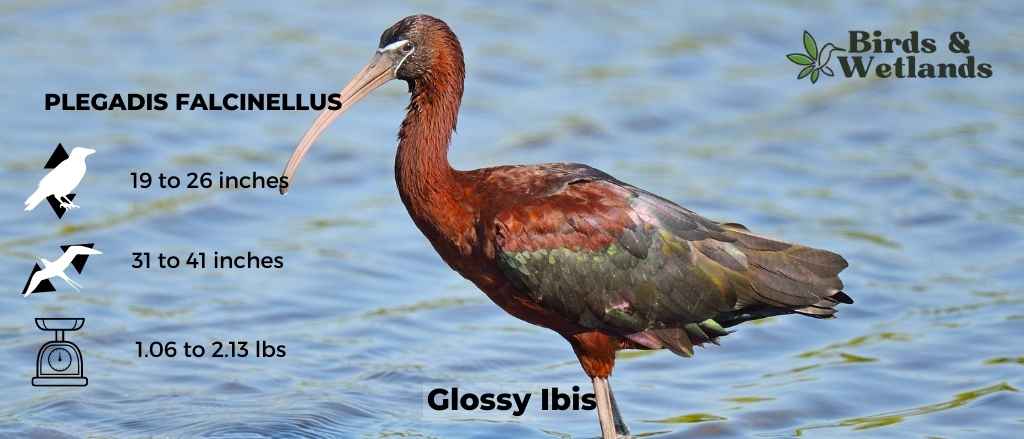
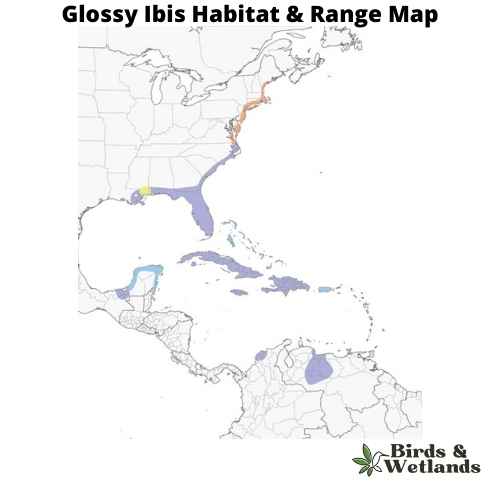
Listen:
Scientific Name: Plegadis falcinellus
Length: 19–26 in
Wingspan: 31–41 in
Weight: 1.069 to 2.138 lb
The Glossy Ibis is a wading bird that has an extensive global range, including parts of the United States, and is the most widespread of all ibis species.
Appearance: The Glossy Ibis is characterized by its slender, curved bill and dark, iridescent body. Its feathers are a rich chestnut and dark green, which appear metallic and shiny, thus giving it the name ‘Glossy’. In breeding season, the area around the bird’s eyes becomes a bright, striking blue.
Diet: Glossy Ibises feed primarily on invertebrates such as insects, worms, and small crustaceans. They use their long, curved bills to probe for food in soft mud, often following the tide in coastal marshes, but also in shallow freshwater wetlands.
Reproduction: Glossy Ibises typically nest in colonies, often with other wading birds. The nests are made from twigs and reeds and are usually placed in trees, shrubs, or reed beds over water. The female lays 3 to 4 blue-green eggs, which are incubated by both parents for about 21 days. Once hatched, the chicks are cared for by both parents and fledge at about 6 weeks.
Wood Stork (Mycteria americana)
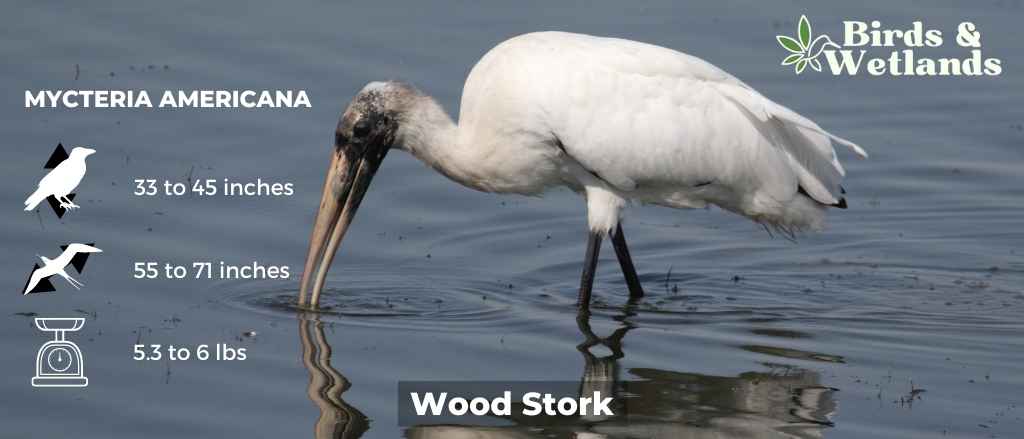

Listen:
Scientific Name: Mycteria americana
Length: 33–45 in
Wingspan: 55–71 in
Weight: 5-6 lb
The Wood Stork is a large wading bird native to America, known for its unique foraging technique and status as the only stork species breeding in the United States.
Appearance: The Wood Stork is characterized by its white body, black flight feathers, and bald, scaly-looking gray head. Its long legs and neck add to its distinct, somewhat prehistoric look. Its bill is long, thick, and curved, aiding in its unique way of feeding.
Diet: The Wood Stork is a carnivore, feeding primarily on fish but also consuming amphibians, insects, and occasionally small rodents. It has a unique feeding method: it wades in shallow water with its bill open and snaps it shut when a fish swims in, often without the bird needing to see its prey.
Reproduction: Wood Storks are colonial nesters, usually nesting in large rookeries and often with other wading birds. They build large stick nests in trees above water, where the female lays 3 to 5 eggs. Both parents share incubation duties, which lasts about 30 days. The chicks fledge after around 8 weeks but continue to return to the nest to be fed by parents for several weeks afterwards.
Mallard

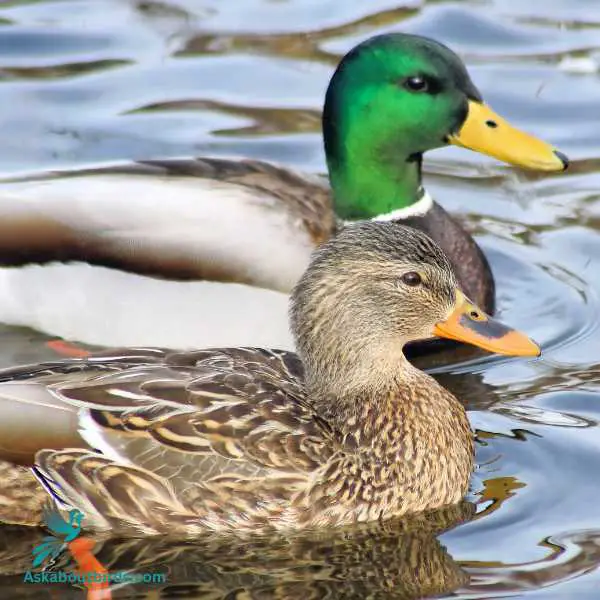
| Feature | Measurement |
|---|---|
| Scientific Name | Anas platyrhynchos |
| Length | 20-26 inches |
| Wingspan | 32-39 inches |
| Weight | 1.6-3.5 pounds |
The Mallard, one of the most recognizable of all ducks, is distinguished by its classic “quack” and its common presence in city parks and wild wetlands.
Appearance: Mallards are large ducks with a hefty body and rounded head. The male is notable for its glossy green head, gray body, and black tail-curl, while the female is mottled brown with an orange-brown bill. Both sexes have a white-bordered, blue “speculum” patch in the wing.
Diet: Mallards are omnivorous, dabbling ducks that eat a wide variety of foods. They are known to feed on aquatic vegetation, insects, worms, and grains. In city parks, they are often seen eating bread, popcorn, and other food provided by humans, although such items are not part of their natural diet.
Reproduction: Mallards nest on the ground on dry land that is close to water, under cover of tall grass or other vegetation. The female typically lays around 8 to 13 eggs and incubates them herself.
Mottled Duck
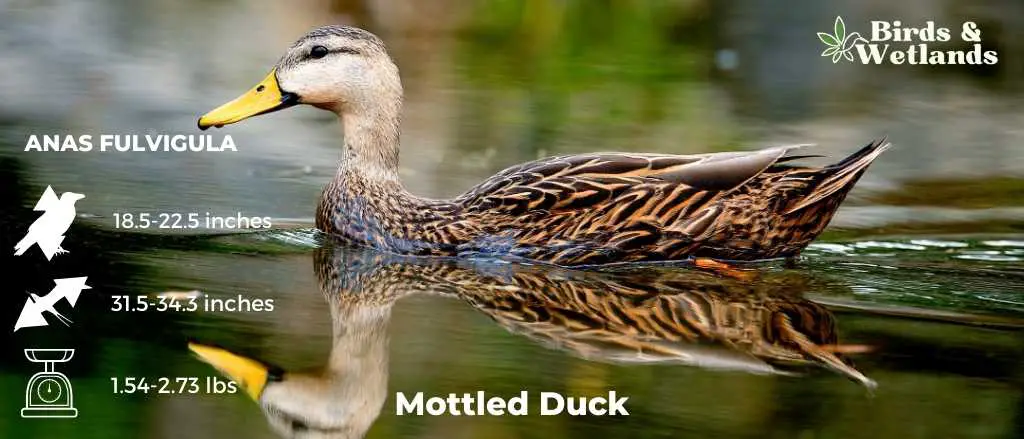
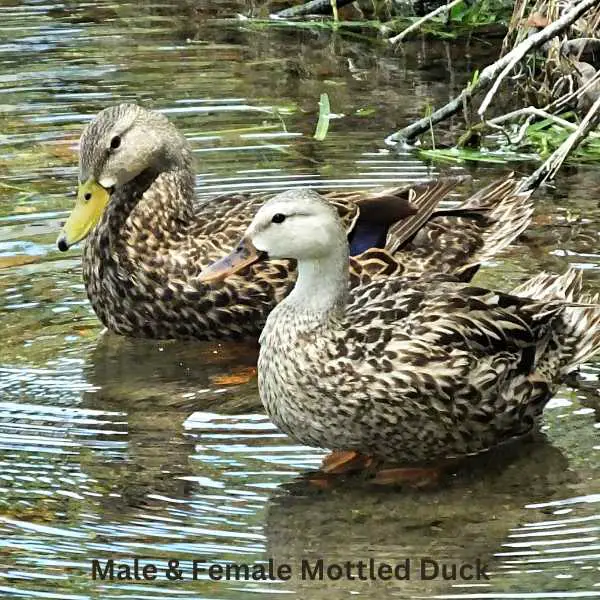
Listen:
Scientific Name: Anas fulvigula
Length: 19.7–22.5 in
Wingspan: 32.7–34.3 in
Weight: 30.9–43.8 oz
The Mottled Duck is a medium-sized waterfowl species known for its subdued coloration and affinity for coastal marshes. It’s primarily found in the southern United States, particularly in Florida and along the Gulf Coast.
Appearance: As the name suggests, Mottled Ducks feature a mottled brown plumage that allows them to blend into their marshy surroundings. They have a fairly uniform color with darker back and lighter underparts. Their bills are yellow to orange, with the males usually sporting a greenish-yellow bill while the females have a more orange one.
Diet: Mottled Ducks are dabbling ducks and they primarily feed on a diet of seeds from aquatic vegetation, grasses, and agricultural crops. They also eat some aquatic insects and crustaceans.
Reproduction: Mottled Ducks pair up for the breeding season and the female typically lays 8 to 10 eggs in a nest hidden in tall grass or reeds. The female incubates the eggs while the male stands guard nearby.
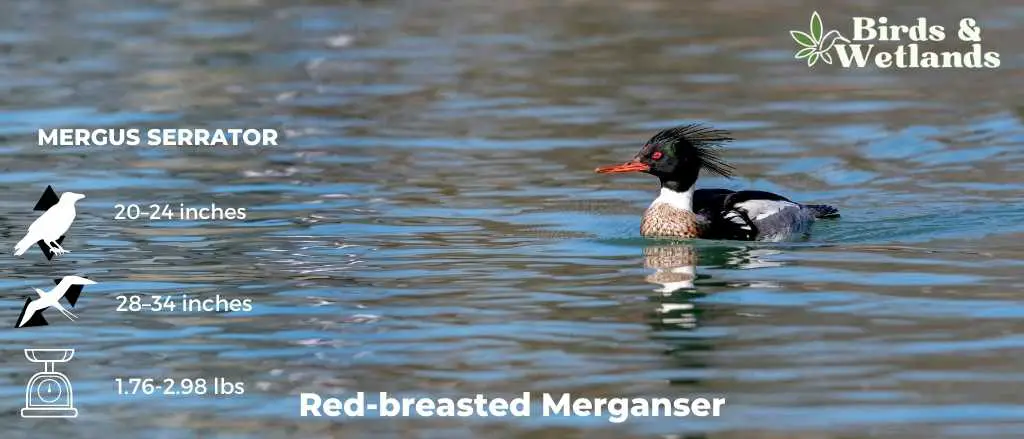

Listen
Scientific Name: Mergus serrator
Length: 20–24 in
Wingspan: 28–34 in
Weight: 28.2 to 47.6 oz
The Red-breasted Merganser is a fascinating diving duck species, recognized for its swift flight and exceptional diving capabilities. They inhabit freshwater and saltwater environments and are quite common in North America and Eurasia.
Appearance: The Red-breasted Merganser boasts an interesting appearance. Males display a dark green head, bright red eyes, and a distinctive, long reddish-brown breast. Their bodies are mainly grey, and they also have a white collar and a thin, serrated bill. Females are more subdued, featuring a rusty cinnamon head with a shaggy crest and grey body.
Diet: Predominantly includes small fish, which they catch by diving underwater. They can also feed on aquatic insects, crustaceans, and occasionally amphibians. Their serrated bill helps them grip slippery prey effectively.
Reproduction: The breeding ground for Red-breasted Mergansers is typically near freshwater lakes or rivers. Females build nests in tree cavities, on the ground hidden in vegetation, or use abandoned nests of other birds. The female lays a clutch of 6 to 12 eggs.
American Coot
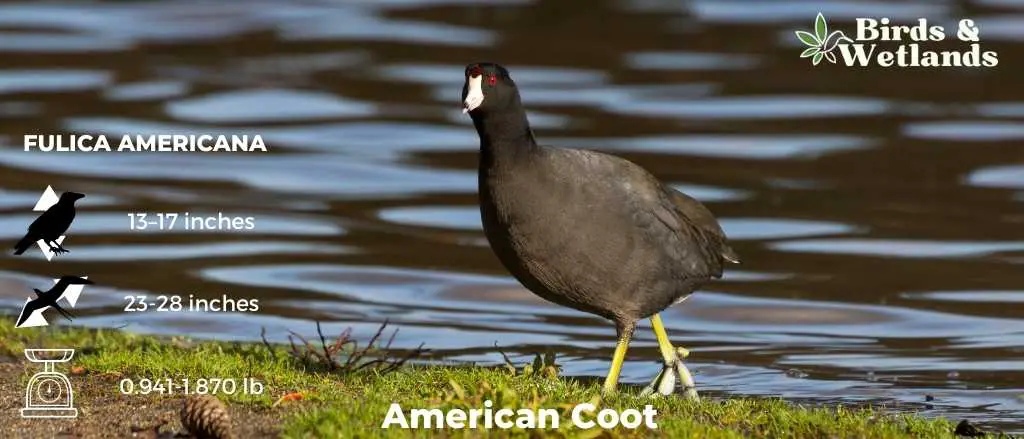
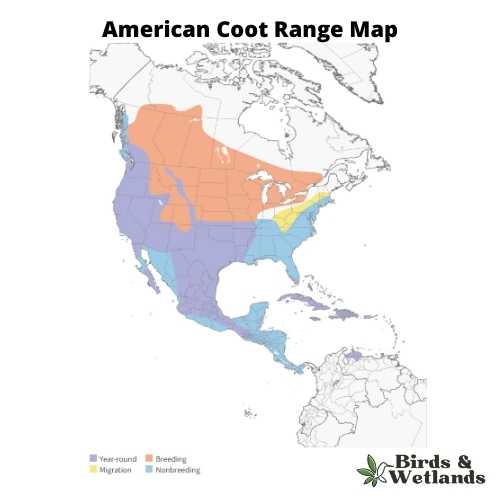
Listen:
Scientific Name: Fulica americana
Length: 13–17 in
Wingspan: 23 to 28 in
Weight: 1.270 to 1.870 lb
The American Coot is a ubiquitous water bird commonly seen in the wetlands, lakes, and ponds of North America, recognized for its adaptability and striking features.
Appearance: American Coots are easily identifiable by their slate-gray bodies, offset by a white, chicken-like bill and a red eye. Their legs are also distinctive, equipped with lobed toes, as opposed to the webbed feet seen in ducks, which assist them in navigating both land and water adeptly.
Diet: While aquatic plants form the bulk of an American Coot’s diet, they aren’t strictly herbivores. These versatile birds also consume small invertebrates and fish, demonstrating their ability to adapt and survive in a variety of habitats.
Reproduction: Nesting for the American Coot usually happens in shallow water bodies, where they construct a floating nest hidden among the vegetation. A clutch can contain between 8 to 12 eggs, all of which are incubated by both parents.
Bald Eagle (Haliaeetus leucocephalus)

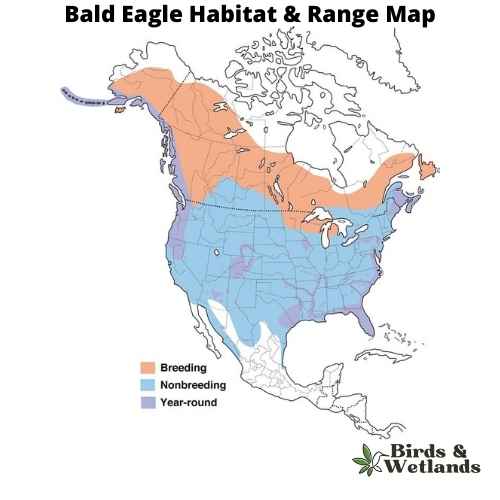
Bald Eagle Sound
Scientific Name: Haliaeetus leucocephalus
Length: 28–40 in
Wingspan: 5 ft 11 in and 7 ft 7 in
Weight: 6.6 -13.9 lb
The Bald Eagle, primarily found in Canada and Alaska, is instantly identifiable by its white head, dark brown body, yellow beak, and a piercing cry. Its sharp, orange-yellow eyes aid in efficient night hunting.
Predominantly residing in North America, occasionally venturing into Asia and Europe, it thrives near water bodies. It perches atop trees, providing a bird’s-eye view of its prey. It feeds on fish, carrion, small mammals like rabbits and squirrels, and reptiles. Hunting involves a swift downward swoop to seize the prey, carrying it back to the nest.
Bald Eagles are monogamous, forming lifelong pairings. They construct vast nests from sticks, lined with moss or grasses. They typically lay 1-3 eggs annually, which hatch around 35 days later. The fledglings leave the nest roughly 6 weeks after hatching, but continue to rely on their parents for nourishment for a further 5-6 months, until they become proficient hunters.
Osprey (Pandion haliaetus)

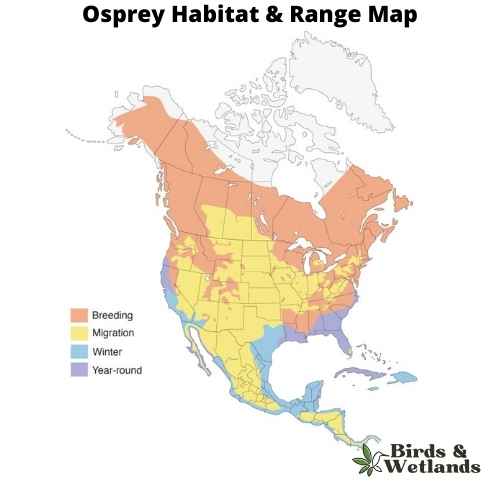
Osprey Sound
Scientific Name: Pandion haliaetus
Length: 50–66 cm (19+1⁄2–26 in)
Wingspan: 127–180 cm (50–71 in)
Weight: 0.9–2.1 kg (2 lb 0 oz – 4 lb 10 oz)
The Osprey, a fascinating bird of prey, is universally known for its exceptional hunting prowess and striking physical characteristics. Osprey are dark brown hawks on the upperparts, contrasting beautifully with the predominantly white underparts, and a distinctive dark band that stretches across the eyes towards the sides of its head.
Equipped with specialized talons and a reversible outer toe, the Osprey’s hunting strategy involves a spectacular plunge-dive into bodies of water, often emerging with a fish securely gripped in its claws.
Found on every continent except Antarctica, the Osprey is a cosmopolitan species favoring habitats near water bodies such as lakes, rivers, and coastal areas, reflecting its piscivorous diet. This bird has a diet almost exclusively of fish, making it a unique member of the raptor family and often referred to as the sea hawk or fish hawk. They locate their prey from the air, often hovering before plunging feet-first to capture a fish. When it comes to breeding, Ospreys are monogamous, often mating for life.
They construct large, bulky nests made of sticks, lined with softer materials, and prefer elevated or isolated areas such as treetops or artificial structures like utility poles. Both parents share the responsibility of incubating the eggs and rearing the chicks.
Northern Pintail
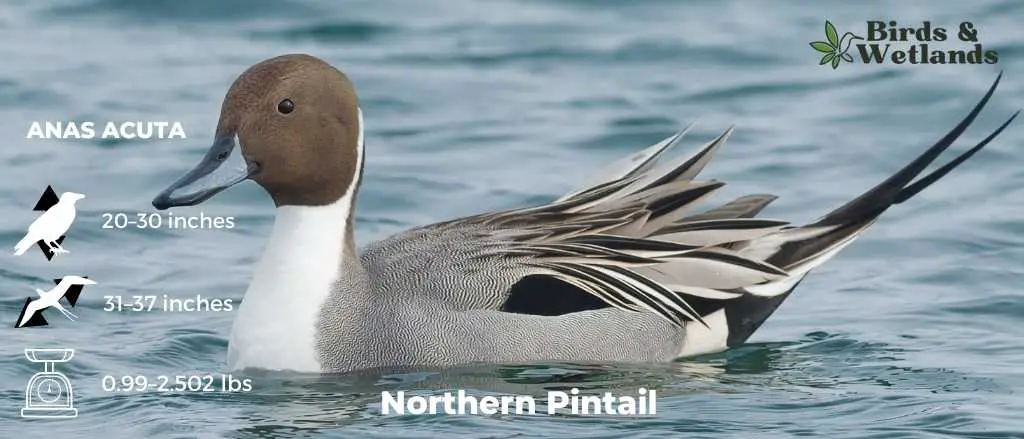
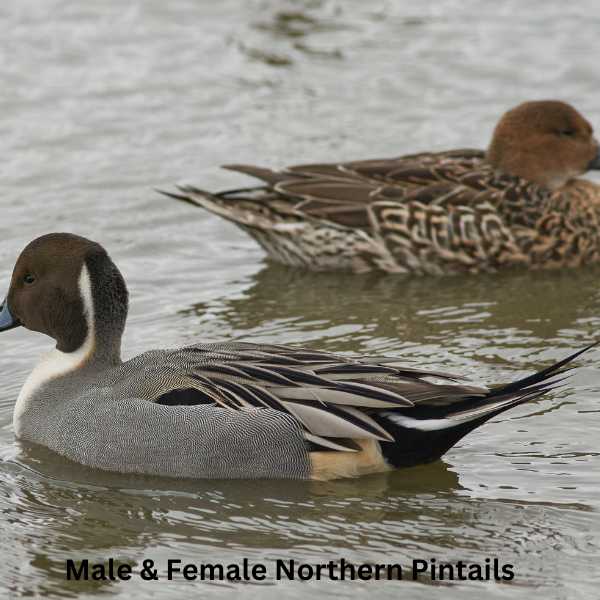
Listen to Northern Pintail
Scientific Name: Anas acuta
Length: 23–30 in
Wingspan: 31–37 in
Weight: 1 –3 lb
The Northern Pintail is a graceful species of duck recognized for their elegance in flight and their sleek bodies and long tails which is pin-shaped.
Male Northern Pintails are celebrated for their distinctive appearance, featuring a chocolate brown head, a white neck, and a grayish body. The most notable characteristic is the long, pointed tail feathers, which give this species its name. Females are more understated in color, sporting a mottled brown plumage.
Diet: Consists primarily of plant matter, including seeds and aquatic vegetation. They are also known to eat insects, especially during the breeding season. The Northern Pintail is often seen dabbling and upending in water bodies to forage for food.
Reproduction: Northern Pintails usually nest on the ground, near water bodies. The female lays a clutch of 7 to 9 eggs and is solely responsible for their incubation, which lasts for about three weeks.
Wood Duck
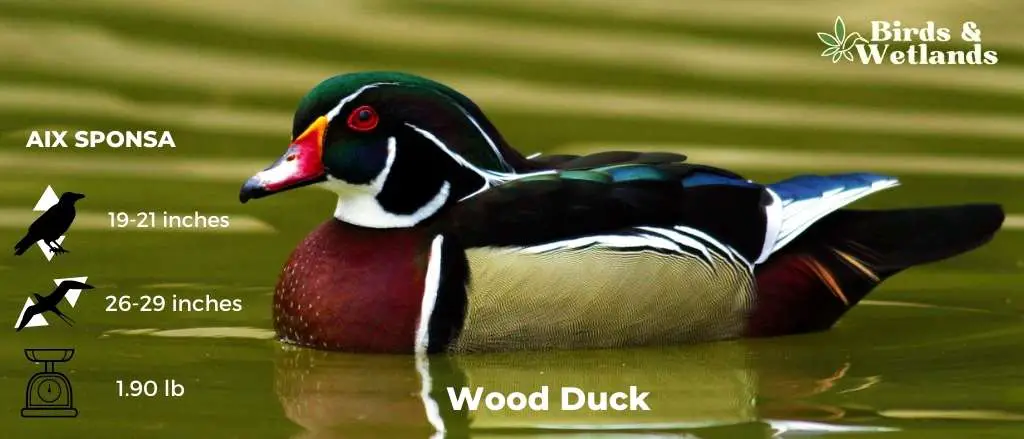
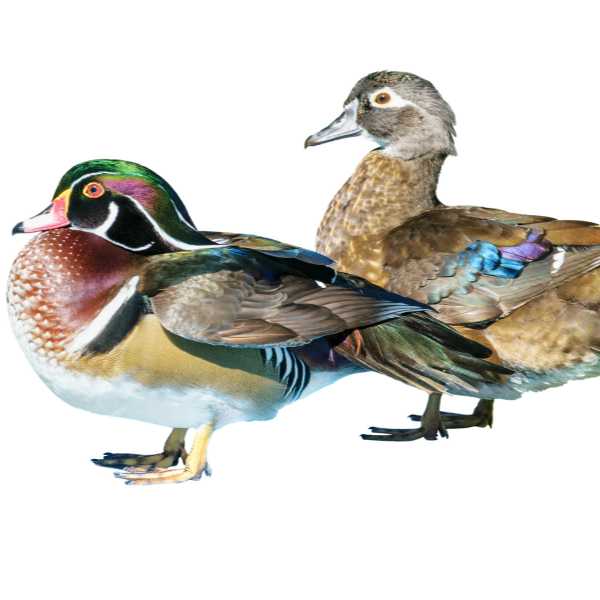
Listen:
Scientific Name: Aix sponsa
Length: 19 to 21 in
Wingspan: 26 to 29 in
Weight: 16.0-30.4 oz
The Wood Duck is an exquisitely colorful waterfowl known for its unique nesting habits and is commonly seen in wooded swamps, marshes, and streams across North America.
Appearance: With their dazzling plumage, Wood Ducks are among the most stunning birds. Males display a multitude of colors, including a green and purple crested head, red eyes, and a white-striped chest, all contrasted with a bronze-colored body. Females, though more subdued with a gray-brown body and white eye-ring, also possess their own charm.
Diet: Wood Ducks have a diverse diet that includes seeds, fruits, and insects, as well as other invertebrates. Their broad diet helps them to adapt to a variety of habitats, whether in the wild or in urban areas with suitable nesting sites.
Reproduction: Unlike most other ducks, Wood Ducks prefer to nest in tree cavities near water, leading to their common name. They will also readily use nest boxes if they’re available. A typical clutch consists of 9 to 14 eggs, which the female incubates alone.
American Oystercatcher
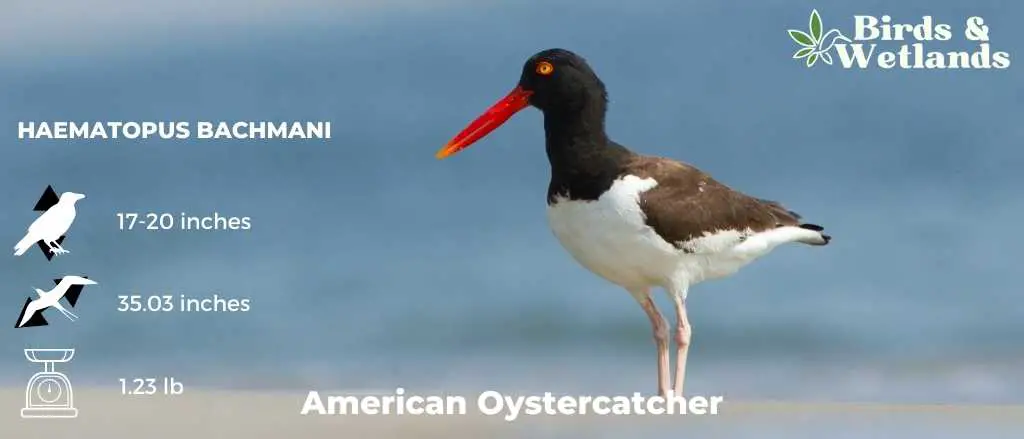

Listen:
Scientific Name: Haematopus palliatus
Length: 17–20 in
Wingspan: 35-in
Weight: 560 g
The American Oystercatcher is a large, coastal bird celebrated for its bold coloration and specialized feeding behavior.
Appearance: American Oystercatchers are notable for their contrasting plumage, with black upperparts, white underparts, and a vivid red-orange bill. They also have distinctive yellow eyes with red-orange eye-rings.
Diet: True to their name, American Oystercatchers primarily feed on shellfish, including oysters, clams, and mussels. They use their strong, sharp bills to pry open the shells of these invertebrates.
Reproduction: American Oystercatchers generally nest on sandy or pebbly beaches, dunes, or salt marsh islands. The female lays a clutch of about 2 to 4 eggs, which are incubated by both parents.
Black Skimmer (Rynchops niger)
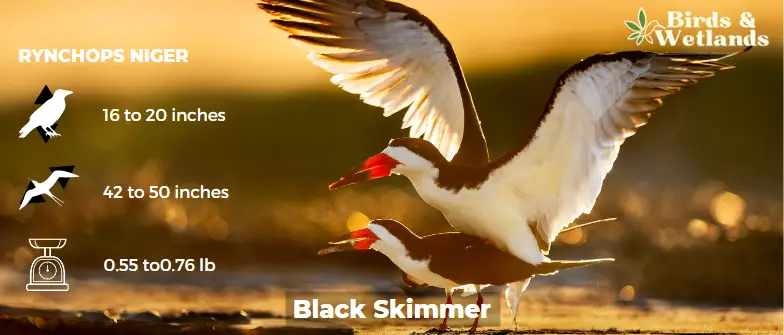
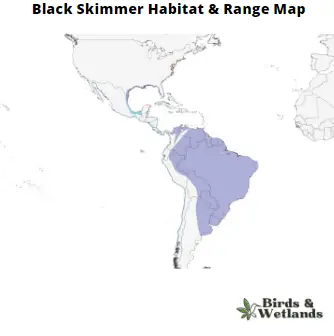
Listen:
Scientific Name: Rynchops niger
Length: 16–20 in
Wingspan: 42–50 in
Weight: 9-12.5oz
The Black Skimmer is a unique coastal bird recognizable for its unusual feeding method, giving it a fascinating presence on the beaches and sandbars it calls home.
Appearance: The Black Skimmer sports a stark contrast in color with a black upper body and white lower body. Its most distinctive feature is its bill, which is knife-thin, bright red at the base, and black at the tip. The bird’s lower mandible is much longer than the upper, an adaptation for its unique feeding style.
Diet: As its name suggests, the Black Skimmer feeds by skimming the surface of water bodies with its elongated lower mandible to catch small fish and crustaceans. It mainly feeds at dawn and dusk, relying on touch to sense prey, making it one of the few birds to feed in near darkness.
Reproduction: Black Skimmers nest in colonies on sandbars, beaches, or dredge spoil islands, with both parents sharing incubation duties. The female lays 1 to 5 eggs, which are then incubated for about 23 days. The chicks are semi-precocial, leaving the nest a few days after hatching but staying nearby for protection and feeding by the parents.
Where to Spot Georgia’s Water Birds
Okefenokee National Wildlife Refuge: Located in the southeastern corner of the state, this refuge is home to an impressive array of bird species, including numerous water birds like Anhingas, Herons, Egrets, and the rare Red-cockaded Woodpecker.
Harris Neck National Wildlife Refuge: This coastal refuge is an important nesting, feeding, and wintering habitat for many species of water birds. Visitors can enjoy viewing species like Wood Storks, Egrets, Herons, and Ibis.
Savannah National Wildlife Refuge: Located on the Savannah River, the refuge offers a variety of habitats that attract a multitude of water birds, including ducks, geese, and wading birds.
Cumberland Island National Seashore: Georgia’s largest barrier island, Cumberland Island is a bird watcher’s paradise, hosting over 300 species of birds throughout the year, including numerous shorebirds and waterfowl.
Altamaha Wildlife Management Area: Located along the Altamaha River, this area is recognized internationally as an important bird area, especially for water-dependent species like Egrets, Herons, and Wood Storks.
| Neighboring State | Best Spots for Birdwatching |
|---|---|
| Florida Water Birds | Everglades National Park, J.N. “Ding” Darling National Wildlife Refuge, St. Marks National Wildlife Refuge |
| Alabama Water Birds | Bon Secour National Wildlife Refuge, Dauphin Island, Wheeler National Wildlife Refuge |
| Tennessee Water Birds | Reelfoot Lake, Radnor Lake State Park, Great Smoky Mountains National Park |
| North Carolina Water Birds | Pea Island National Wildlife Refuge, Alligator River National Wildlife Refuge, Lake Mattamuskeet |
| South Carolina Water Birds | Congaree National Park, Bear Island Wildlife Management Area, Cape Romain National Wildlife Refuge |
FAQs on Waterbirds in Georgia
What Georgia birds are there in early Spring?
In early spring, various water bird species can be found in Georgia’s lakes, rivers, and coastal areas. Some species are year-round residents, while others are migrating through. Here are some of the water birds you might see in Georgia in early spring:
- Varies species of ducks: Known for their colorful plumage, Wood Ducks can be found in the marshes and swamps of Georgia during early spring. Other ducks inflcude green winged teals and mallards.
- Osprey (Pandion haliaetus): These birds of prey can be seen near lakes and rivers, diving to catch fish.
- Various species of Egrets and Herons: This includes Snowy Egrets, Little Blue Herons, and Green Herons. Closely releated are northern shovelers and other long necked birds.
- Various species of Terns and Gulls: These species are often found along the coast and include Royal Terns, Caspian Terns, Laughing Gulls, and Ring-billed Gulls. Known for being lock necked birds

